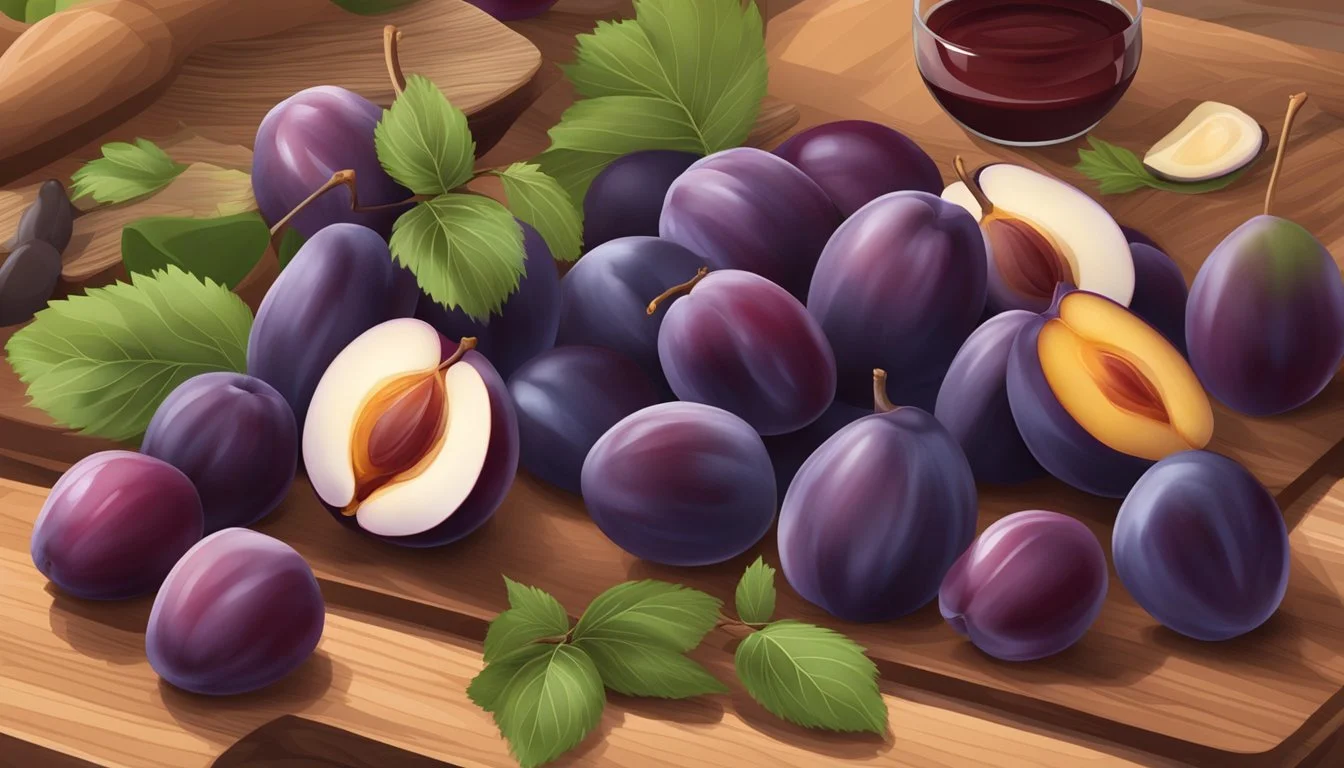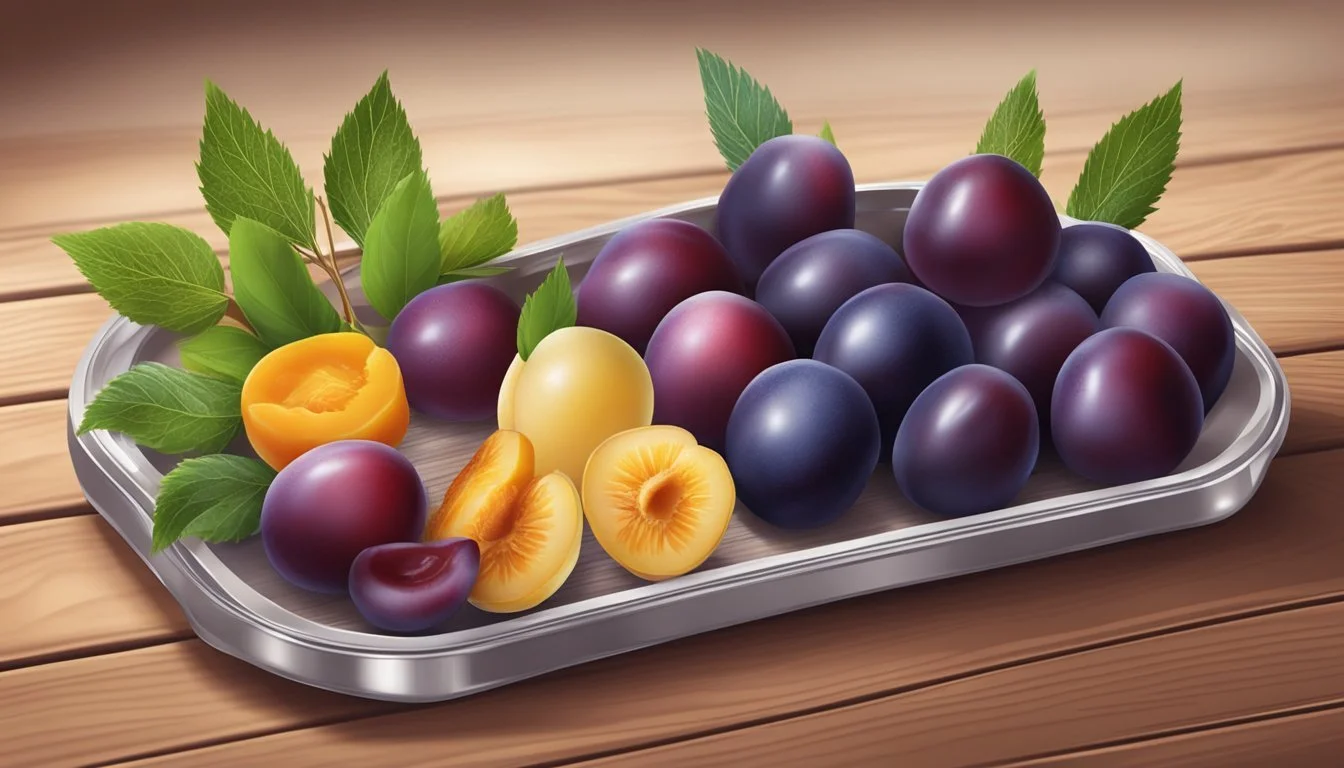Plums Substitutes
Best Alternatives for Sweet and Savory Dishes
Plums are a versatile fruit used in a variety of dishes, but when they are not available, several substitutes can effectively take their place. Apricots, for example, offer a sweet, tangy flavor and are rich in vitamins A, C, and E, making them an excellent alternative to plums. For those looking for a refreshing and subtly sweet substitution, Asian pears can be used in equal amounts to replace plums in most recipes.
For slow-cooked dishes that benefit from a fruit's sweetness, prunes (dried plums) or figs are ideal choices. These fruits break down during long cooking times, enhancing the flavor and tenderness of meats. Persimmons, with their sweet, honey-like flavor and custard-like texture, add a unique twist to any dish requiring plums.
When it comes to sauces like plum sauce, garlic teriyaki sauce can be an effective replacement, providing a different but equally satisfying flavor profile. Another creative substitute for plum extract involves blending ginger root with teriyaki sauce, garlic, and other spices to mimic the sweetness and complexity of the original ingredient. These alternatives ensure that whether it's for fruit or sauce, there are delicious and effective substitutes for plums in any recipe.
Understanding Plum Varieties and Their Uses
Different varieties of plums can enhance dishes with their unique flavors and textures. Plums can add sweetness or tartness to meals and desserts, with plum sauce bringing an extra layer of complexity to various culinary creations.
Culinary Versatility of Plums
Plums come in numerous varieties, each with distinct characteristics. Greengage plums are exceptionally sweet and are often used in desserts due to their high sugar content. Satsuma plums are commonly enjoyed fresh or in jams, boasting a deep purple skin and sweet, juicy flesh.
Moyer plums are known for their sweet taste and are excellent for baking or making dried plums (prunes). Other types, such as those with tart skins and sweet yellow flesh, can balance flavors in both sweet and savory dishes. Their versatility makes them a staple in many kitchens.
Plum Sauce and Its Applications
Plum sauce, often made from sweet or tart plums, is a popular condiment in various cuisines. This sauce pairs wonderfully with savory dishes, especially duck, as it complements the richness of the meat. Its sweet and tangy profile also enhances pork, chicken, and tofu.
In addition to meats, plum sauce can be used as a glaze for roasted vegetables or as a dipping sauce for appetizers. It can also add depth to marinades and stir-fries, making it a versatile ingredient in the kitchen. By incorporating plum sauce, dishes gain a unique, flavorful dimension.
Selecting Plum Substitutes
When choosing a substitute for plums, it's important to consider the type of dish, the flavor profile, and the specific recipe requirements. This ensures the substitute maintains the desired taste and texture.
Based on Dish Type
Desserts: For sweet dishes like pies and tarts, fruits such as apricots or persimmons work well. Apricots are similar in sweetness and texture, making them a solid replacement.
Sauces: In sauces, prunes (dried plums) or blackberries can be used. Prunes provide a rich, sweet flavor, while blackberries add a tart and vibrant taste.
Salads: For fresh and crisp textures, choose fruits like Asian pears or nectarines. They offer a juicy and refreshing element similar to that of plums.
Considering Flavor Profiles
Sweet: Use apricots or prunes for a sweet flavor. Apricots are slightly tart but become sweet when ripe. Prunes are naturally sweet and can enhance both desserts and savory dishes.
Tart: Gooseberries or cranberries are ideal for a tart profile. These fruits bring a sharp, tangy flavor that can balance sweet and savory dishes.
Umami: For dishes requiring a hint of umami, consider using figs or dates. These fruits offer a deep, rich sweetness that complements savory ingredients.
Substitute Options by Recipe
Baking: When baking, use apricots or peaches as substitutes. They can provide a similar texture and sweetness to plums.
Slow-Cooked Meals: Prunes or figs are excellent for slow-cooked dishes. They break down over time, imparting sweetness and tenderness to meat dishes.
Jams and Sauces: To replace plum extract or sauce, a mixture of pitted prunes, soy sauce, garlic, and dry sherry can create a similar depth of flavor.
Salads and Fresh Use: Asian pears and nectarines are great in salads or as fresh alternatives. They offer crunch and sweetness that are comparable to fresh plums.
Using these guidelines, you can select the most appropriate plum substitute, ensuring your dish maintains its desired taste and texture.
Fruit-Based Substitutes
For those seeking to replace plums in various recipes, there are numerous fruit-based options available that offer similar flavors and textures. Key alternatives include stone fruits and other fruit varieties that can enhance a wide array of dishes.
Stone Fruits as Alternatives
Apricots
Apricots make an excellent substitute for plums due to their similar texture and flavor profile. They can be used in equal quantities in recipes, providing a slightly tart and sweet taste.
Peaches and Nectarines
Peaches and nectarines also serve as great alternatives. Both fruits maintain a balance of sweetness and juiciness that can mimic the taste of plums. These can be especially useful in baking and cooking where you need that extra bit of natural sugar.
Cherries
Cherries, particularly the sweet varieties, can offer a more intense flavor compared to plums, adding a richer taste to desserts and sauces. They work well in compotes, pies, and even salads.
Other Fruit Options
Apples
Apples can be a versatile replacement for plums. While they are firmer and less juicy, they absorb flavors well and can be cooked down to a similar texture in recipes such as stews or sauces.
Pears
Pears provide a juicy and subtly sweet alternative. They can be sliced and used in both savory and sweet dishes, bringing a refreshing taste to salads or baked goods.
Figs
Figs, with their sweet and honey-like flavor, can replace plums in recipes where a natural sweetness is desired. They blend well in jams, desserts, and even savory applications like sauces and glazes.
Each of these substitutes offers unique characteristics while maintaining the essence that plums bring to various culinary creations. By considering the desired flavor and texture, these fruits can be effectively used to enhance your dishes.
Plum Sauce Alternatives
Plum sauce alternatives can be homemade using various ingredients to mimic the flavor, or purchased as readily available commercial substitutes.
Homemade Plum Sauce Recipes
Creating a homemade plum sauce can be both straightforward and rewarding. Raisins soaked for an hour and blended with sesame oil, miso paste, mustard, garlic, and crushed red pepper offer an excellent alternative. The mixture matches the sweet and tangy characteristics of traditional plum sauce.
Another option is ketchup-based plum sauce. Combine 1 cup of ketchup, ½ cup of plum jam, and ¼ cup of honey in a saucepan. Add 1 tablespoon of apple cider vinegar, soy sauce, and 1 teaspoon of smoked paprika. Bring it to a boil, then let it simmer until thickened, about 10-15 minutes.
Commercial Plum Sauce Substitutes
Various commercial sauces can step in for plum sauce in recipes. Hoisin sauce, originating from Cantonese cuisine, is slightly spicier but pairs well with fried foods like egg rolls and chicken wings. It maintains a similar consistency and sweetness, making it a versatile substitute.
Teriyaki sauce is another available option that primarily includes soy sauce, sake, ginger, and sugar. This Japanese marinade offers a balance of salty and sweet, ideal for meat dishes. Though it lacks the fruitiness of plum sauce, its flavor complexity can be a pleasing alternative in many recipes.
Condiments and Spices as Substitutes
When plums or plum sauce are unavailable, certain condiments and spices can effectively stand in their place. These alternatives can replicate the sweet, savory, and tangy qualities of plum-based dishes, using ingredients such as vinegar, honey, and ginger to balance the flavors.
Creating Flavor with Spices
Spices are key in replicating the depth found in plum sauce. Five-spice powder combines star anise, cloves, cinnamon, Szechuan peppercorns, and fennel seeds, mimicking the complex flavors of plum sauce. Ginger and garlic add pungency and warmth. Chili introduces a subtle heat that contrasts well with sweetness.
A mixture of these spices, perhaps with a bit of brown sugar or white sugar, can enhance marinades and sauces intended to replace plum-based recipes.
Savory Condiments
Several condiments, like hoisin sauce and soy sauce, serve as effective substitutes for plum sauce in various dishes. Hoisin sauce is particularly comparable due to its similar use and consistency. It carries a sweet and salty balance enhanced by ingredients like soybeans and garlic.
Black bean sauce is another option, offering umami depth and pairing well with vinegar for additional tang. These substitutions work well in stir-fries or as dipping sauces.
Sweet and Tangy Alternatives
For those seeking to replicate the sweetness and tang of plums, options like honey, apple cider vinegar, and mustard can be combined. A simple mix of honey and vinegar mirrors the sweet-sour aspect, while mustard can add a unique sharpness.
Garlic teriyaki sauce is also effective, combining sweet, tangy, and savory notes, ideal for noodles, rice, or as a glaze. Incorporating brown sugar or white sugar can further adjust the sweetness to match specific tastes.
Cooking with Plum Substitutes
Plum substitutes, such as apricots, prunes, and Asian pears, can be effectively integrated into culinary recipes. They bring unique flavors and textures to a variety of dishes without compromising the intended taste and consistency.
Adjustments for Sweetness and Texture
Sweetness and texture are essential when replacing plums in recipes. Apricots and prunes maintain a sweet and tangy profile similar to plums. When using apricots, adjusting the quantity of sugar in the recipe may be necessary since apricots are slightly sweeter.
For a firmer texture, consider Asian pears. They add a crisp bite that plums provide in salads and desserts. If a softer texture is preferred, soaking the alternatives like prunes in a bit of warm water can help achieve the needed consistency.
Marinating and Glazing Techniques
For marinating and glazing, plum substitutes can impart a deep, rich flavor to meats like pork, chicken, duck, and even beef. Apricot puree works well as a basting sauce, while a mixture of prunes and garlic can be used for a tenderizing marinade.
Asian pears' natural enzymes make them ideal for marinating tougher cuts of meat. They help break down proteins and enhance flavors. Using these substitutes in a glaze for roasted duck can produce a luscious, caramelized surface reminiscent of traditional plum sauce.
Utilizing Substitutes in Baking
In baking, plums' substitutes should mimic both flavor and moisture content. Prune puree can be used to maintain moisture in cakes and muffins. This substitute not only provides a similar taste but also keeps baked goods soft and moist.
Asian pears can add both sweetness and a mild crunch when included in tarts or pies. Apricots, whether fresh or dried, can be seamlessly integrated into dessert recipes such as cobblers and crisps. They offer a slightly tangy flavor that complements various pastry bases.
When substituting, be mindful of the texture, moisture, and sweetness to ensure the final product closely matches the expected outcome of the original ingredient. Proper adjustments can lead to a delicious and satisfying meal or dessert.
Health and Nutritional Considerations
Both plums and their substitutes offer unique nutritional profiles. When choosing a substitute, it's essential to consider caloric intake, sugar content, and overall nutritional value, including fiber and vitamin contributions.
Caloric and Sugar Content
Plums are relatively low in calories, with one medium-sized plum containing about 30 calories. This makes them a suitable option for those monitoring their caloric intake. They contain around 7.5 grams of carbohydrates, primarily from natural sugars.
In comparison, prunes have a higher calorie content, with approximately five times the calories of plums, due to the lower water percentage. This also means prunes have higher sugar content. Apricots and Asian pears are good alternatives with moderate calorie and sugar levels. Persimmons offer a sweet taste but should be consumed in moderation due to their higher sugar content.
Benefits of Plum and Its Substitutes
Plums are rich in vitamin C, vitamin A, and dietary fiber, contributing to overall health by supporting the immune system and digestion.
Apricots provide a good source of vitamins A and C and are also high in fiber. Asian pears contain a crisp texture and provide a refreshing amount of vitamins and fiber. Persimmons, with their sweet, honey-like flavor, offer high levels of vitamin A, vitamin C, and beneficial fibers.
Despite their higher calorie and sugar content, prunes are also nutrient-dense, containing higher amounts of fiber and various vitamins, making them a good option for those needing more energy-dense foods.
Choosing the right substitute depends on specific dietary needs and nutritional goals.
Global Influences on Plum Substitutions
Plums are widely used in different culinary traditions around the world. Various cultures have found suitable substitutes for plums, tailoring the flavors to fit their unique dishes.
Chinese Cuisine and Plum Sauce
In Chinese cuisine, plum sauce is a staple condiment, often used for dipping and glazing. When plums are unavailable, hoisin sauce and teriyaki sauce can be used as substitutes due to their sweet and savory profiles. Additionally, the flavor of plum sauce can be mimicked by pairing bean paste with sesame oil and a touch of sweetness.
Plum sauce in China is also integral for recipes like Peking Duck. Similarly, ponzu sauce—a citrus-based sauce—can add a zesty twist to dishes requiring plum sauce. These substitutions cater to traditional flavors while offering new dimensions, ensuring the dish remains authentic.
Influence of Other National Cuisines
Other national cuisines also adapt substitutions for plums. In Western recipes, substitutes like apples, peaches, nectarines, and apricots are common. For example, apricots offer a similar texture and sweetness, making them ideal in both desserts and jams.
The Japanese use Asian pears as substitutes due to their crisp and juicy texture in place of plums in salads and pickles. Persimmons are another alternative, with their sweet, honey-like flavor fitting well in baked goods and sauces.
By incorporating diverse ingredients, global cuisine maintains the essence of plum-based dishes, showcasing culinary creativity and adaptability. Whether through direct substitution or creative flavor matching, these alternatives keep traditional recipes alive.
Serving and Presentation Tips
Plum substitutes can elevate various dishes when used thoughtfully. Focus on sauces and finishes to enhance the flavors of your meals.
Dipping Sauces and Condiments
Pairing the right dipping sauce with dishes like dumplings, egg rolls, and spring rolls can create an outstanding flavor profile. For example, apricot-based sauces can replicate the sweet and tangy nature of plums.
Ingredients:
Apricot puree
Vinegar
Sugar
Ginger
Garlic
Combine these ingredients in a saucepan. Simmer until thickened. This sauce works well as a dipping condiment for wontons and other appetizers. For a richer option, use blends of plum jam, honey, and apple cider vinegar. This makes a great finishing sauce as well.
Garnishing and Finishing Touches
Using plum substitutes effectively as garnishes can add a visual and taste appeal. Slices of Asian pear can garnish salads or main dishes, providing a crisp, sweet crunch similar to plums. Persimmons can be cubed and used as a topping for desserts or savory dishes, offering honey-like sweetness.
A few slices of apricots can be laid over grilled meats or blended into a glaze. Adding a sprig of mint or a light dusting of powdered sugar can elevate the presentation aesthetically.











